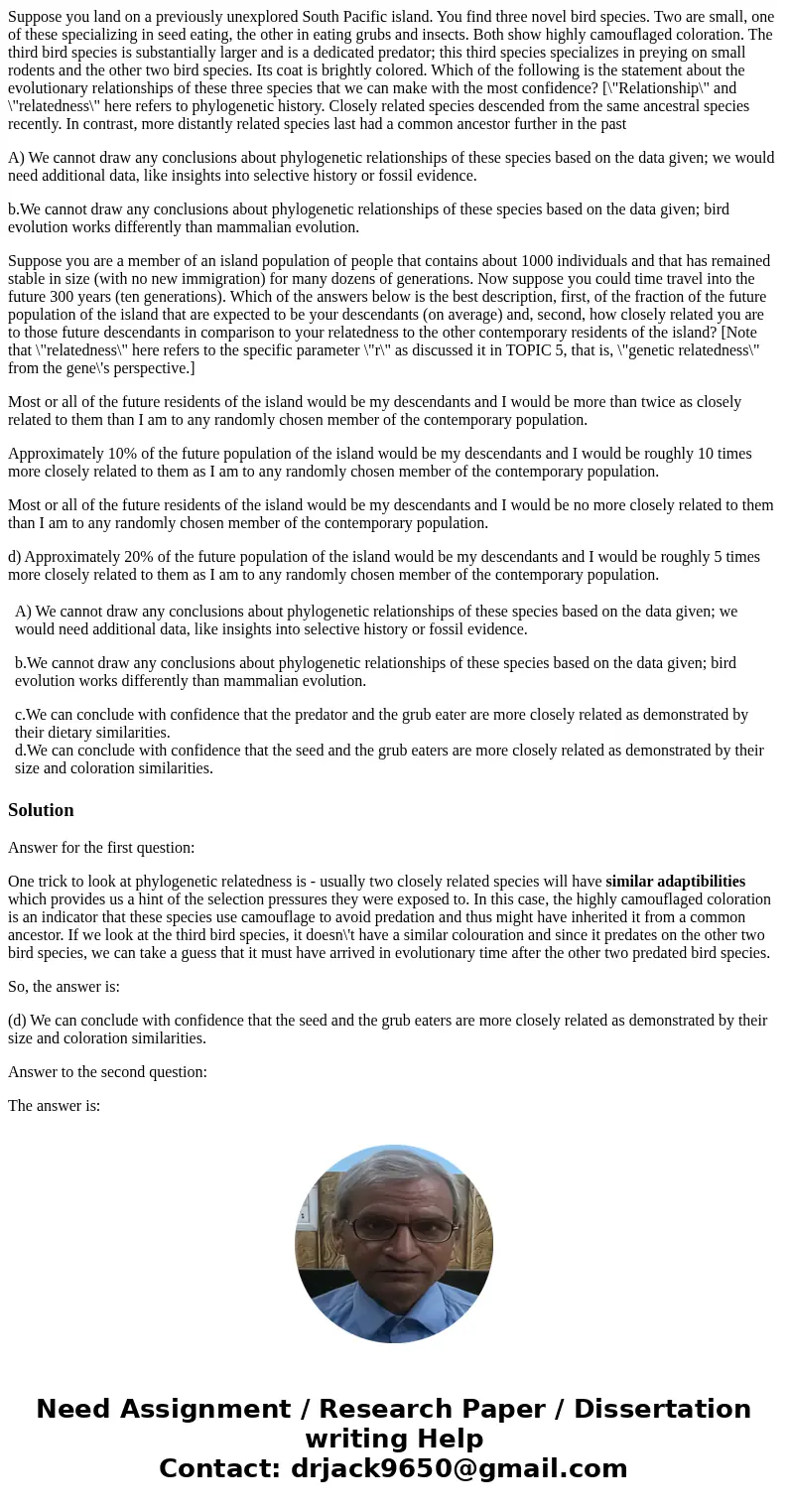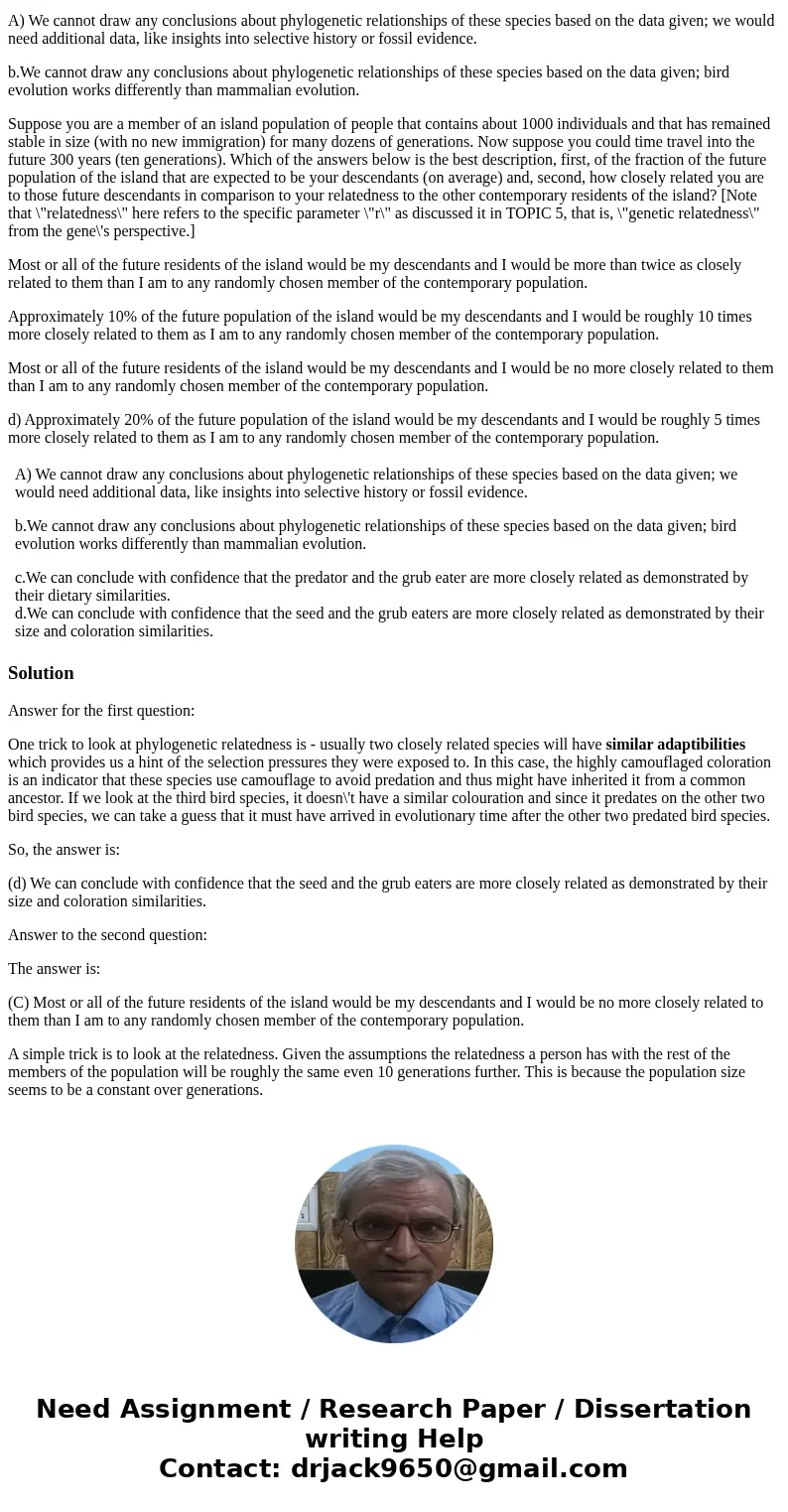Suppose you land on a previously unexplored South Pacific is
Suppose you land on a previously unexplored South Pacific island. You find three novel bird species. Two are small, one of these specializing in seed eating, the other in eating grubs and insects. Both show highly camouflaged coloration. The third bird species is substantially larger and is a dedicated predator; this third species specializes in preying on small rodents and the other two bird species. Its coat is brightly colored. Which of the following is the statement about the evolutionary relationships of these three species that we can make with the most confidence? [\"Relationship\" and \"relatedness\" here refers to phylogenetic history. Closely related species descended from the same ancestral species recently. In contrast, more distantly related species last had a common ancestor further in the past
A) We cannot draw any conclusions about phylogenetic relationships of these species based on the data given; we would need additional data, like insights into selective history or fossil evidence.
b.We cannot draw any conclusions about phylogenetic relationships of these species based on the data given; bird evolution works differently than mammalian evolution.
Suppose you are a member of an island population of people that contains about 1000 individuals and that has remained stable in size (with no new immigration) for many dozens of generations. Now suppose you could time travel into the future 300 years (ten generations). Which of the answers below is the best description, first, of the fraction of the future population of the island that are expected to be your descendants (on average) and, second, how closely related you are to those future descendants in comparison to your relatedness to the other contemporary residents of the island? [Note that \"relatedness\" here refers to the specific parameter \"r\" as discussed it in TOPIC 5, that is, \"genetic relatedness\" from the gene\'s perspective.]
Most or all of the future residents of the island would be my descendants and I would be more than twice as closely related to them than I am to any randomly chosen member of the contemporary population.
Approximately 10% of the future population of the island would be my descendants and I would be roughly 10 times more closely related to them as I am to any randomly chosen member of the contemporary population.
Most or all of the future residents of the island would be my descendants and I would be no more closely related to them than I am to any randomly chosen member of the contemporary population.
d) Approximately 20% of the future population of the island would be my descendants and I would be roughly 5 times more closely related to them as I am to any randomly chosen member of the contemporary population.
| A) We cannot draw any conclusions about phylogenetic relationships of these species based on the data given; we would need additional data, like insights into selective history or fossil evidence. b.We cannot draw any conclusions about phylogenetic relationships of these species based on the data given; bird evolution works differently than mammalian evolution. c.We can conclude with confidence that the predator and the grub eater are more closely related as demonstrated by their dietary similarities.d.We can conclude with confidence that the seed and the grub eaters are more closely related as demonstrated by their size and coloration similarities. |
Solution
Answer for the first question:
One trick to look at phylogenetic relatedness is - usually two closely related species will have similar adaptibilities which provides us a hint of the selection pressures they were exposed to. In this case, the highly camouflaged coloration is an indicator that these species use camouflage to avoid predation and thus might have inherited it from a common ancestor. If we look at the third bird species, it doesn\'t have a similar colouration and since it predates on the other two bird species, we can take a guess that it must have arrived in evolutionary time after the other two predated bird species.
So, the answer is:
(d) We can conclude with confidence that the seed and the grub eaters are more closely related as demonstrated by their size and coloration similarities.
Answer to the second question:
The answer is:
(C) Most or all of the future residents of the island would be my descendants and I would be no more closely related to them than I am to any randomly chosen member of the contemporary population.
A simple trick is to look at the relatedness. Given the assumptions the relatedness a person has with the rest of the members of the population will be roughly the same even 10 generations further. This is because the population size seems to be a constant over generations.


 Homework Sourse
Homework Sourse